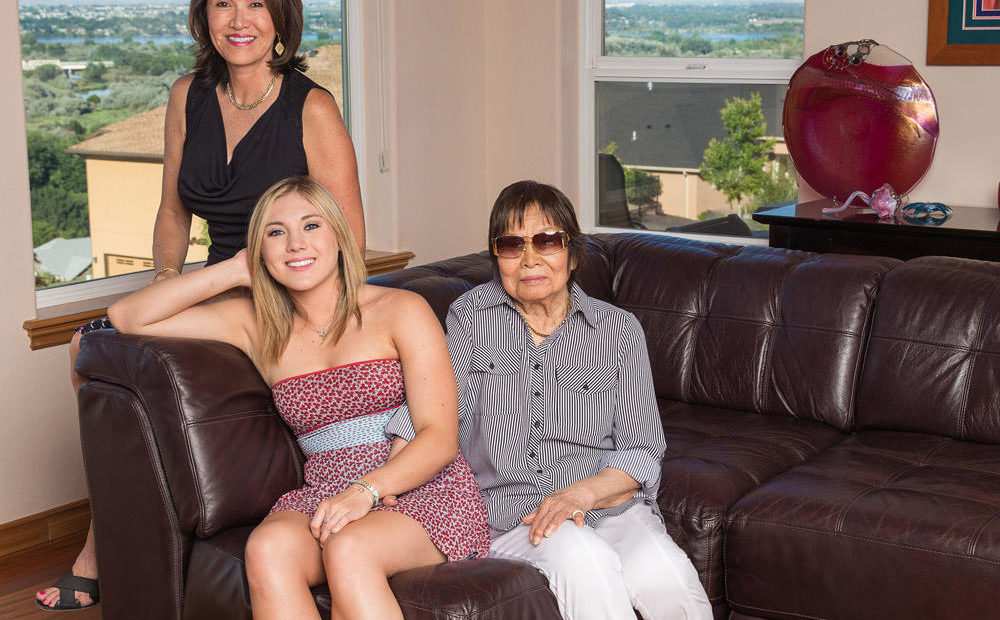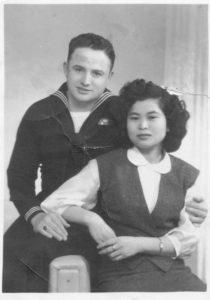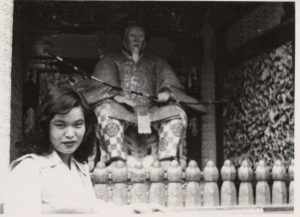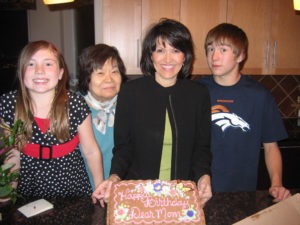
Daughters Of Hanford: 3 Generations Shaped By The Atomic Bomb On Nagasaki
Listen
Wherever she was, she stood out for being half white, or half Japanese. Shirley Olinger will only whisper the racist names she was called as a girl.
She was born in Japan to a Japanese mother. Her father is a white U.S. Navy man. She grew up near military bases in the continental U.S. and Hawaii.
“I’d come home crying being called something not nice. And my mom would say, ‘Just punch that kid in the face,’” Olinger said. “And of course my dad being the white guy would say, ‘Oh, just ignore it.’”

Frank and Kazuko Olinger in Iwakuni, Japan 1956.
Olinger’s daughter, Sarah McCormick, had a very different experience growing up. She’s 18 and a newly-graduated “Bomber” from Richland High School. She has blonde hair and blue eyes.
“Most people don’t know — whenever I tell them I’m Japanese they are really surprised,” she said. “They don’t think I look like it at all.”
‘It makes a lot of sense that I’m here’
Olinger confronted racism and gender stereotypes into adulthood, as she became one of few women engineers working for the government back in the ‘80s. Her second job: The Navy at Pearl Harbor working with dry docked nuclear subs.
But first she had an interview.
“And he said, ‘Well you know, there aren’t very many women here, Shirley. And we’re not going to stop cussing just because we hire women,’” Olinger recalled. “And I just kind of looked at him very seriously and said, ‘Well, my dad was a chief in the Navy and I’ve been around a lot of men that have cussed so I think I can handle it.’”
Later she worked at other U.S. nuclear sites during part of the Cold War. In 2007, Olinger became a top U.S. Department of Energy cleanup manager at Hanford.
Olinger is now a nationwide consultant on nuclear waste. She still works a bit on Hanford, but for several years, she was the woman in charge of 56 million gallons of radioactive tank waste. All this highly-radioactive Hanford sludge is the result of plutonium production during World War II and the Cold War.
Plutonium for bombs.
“I don’t know if it’s meant to be that I’m here,” she said. “But it makes a lot of sense that I’m here. To be a part of this cleanup, based on my history.”
Roots in Nagasaki
Kazuko [Ozaki] Nishimoto is Olinger’s mother and McCormick’s grandmother. When the petite 86-year-old was just a girl, she usually spent the summers in Nagasaki with her grandmother.

Kazuko Nishimoto (then Ozaki) is seen as a 24-year-old in front of a temple in Nikko, Japan in 1953.
“I used to sleep with grandma, she tell me all the story,” Nishimoto said. “I go all over with grandma. Yes, she is really close to me.”
But back in the summer of 1945, the war was on and Nishimoto was staying with her father. In August of that year, an atomic bomb was dropped on Nagasaki. It used Hanford plutonium.
Two long weeks later, Nishimoto learned that her grandmother and cousins had survived.
“Yeah, very close distance, you know,” Nishimoto said. “But I think all my cousin they look like they OK.”
“Except a lot of them had thyroid problems, and the one cousin’s daughter couldn’t have children,” Olinger added. “And you had thyroid cancer.”
Nishimoto, Olinger and McCormick visited Nagasaki, Japan’s memorial together several years back. Olinger says … “War is hell.”

Sarah McCormick, left, Kazuko Nishimoto, Shirley Olinger and Sean McCormick celebrate Nishimoto’s birthday in 2004.
McCormick is now at Montana State studying to become an engineer. For her granddaughter — Nishimoto hopes the world will never know another atomic bomb.
“I hopes peace,” she said. “Yeah, nothing happen. Yeah, yeah.”
Olinger said all their lives are bonded fast to the bomb and Hanford.
9(MDEwMDE0NjgyMDEzNDY0NDY5NTBmNTc1Yg004))
Related Stories:

Idaho law: Health care providers, institutions can refuse care
A new law in Idaho gives health care professionals the right to refuse care based on personal beliefs or principles. (Credit: AP / Charlie Litchfield) Listen (Runtime 00:49) Read A

Whitman County reports first flu-related death of the season
Hospitalman Yenifer Gutierrez, left, and Hospitalman Brashea Ojeda treat COVID patients in the ICU Aboard USNS Comfort in April of 2020. Influenza deaths surpassed COVID-19 deaths for this first time

Unpacked: Giving spiritual meaning to food during Lent
For Lent this year, the Rev. Rene’ Devantier of Spokane’s Fowler United Methodist Church uses real food and drink elements. (Credit: Cody Wendt / FāVS News) Listen (Runtime 1:47) Read













